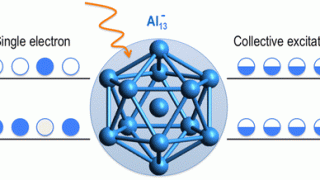
Plasmonic resonances in an aluminium magic cluster
Al13 − is one of the most attractive of the so-called magic clusters. It has a perfect icosahedral symmetry with an aluminum atom at the center, a closed-shell electronic configuration (40 electrons), and a large highest occupied molecular orbital−lowest unoccupied molecular orbital (HOMO− LUMO) gap. These features result in an unusual stability and chemical inertness […]








